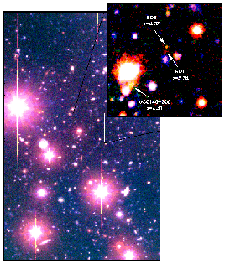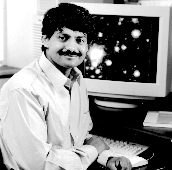|
|
The Hunt For First Primeval Galaxy May Be OverDiscovery: Serendipity leads astronomers to the most distant known object
Emil Venere |

 The most distant known object in the cosmos--a young galaxy
more than 12 billion light-years from Earth--has been spotted by
a team of astronomers. And the accidental discovery may represent
a sign of things to come.
The most distant known object in the cosmos--a young galaxy
more than 12 billion light-years from Earth--has been spotted by
a team of astronomers. And the accidental discovery may represent
a sign of things to come.
"It is an extremely exciting discovery, since so little is known about this stage of the universe, in terms of the objects that lived there, or how galaxies--giant collections of stars-- might form," says Arjun Dey, the Hopkins astronomer who led the team making the discovery.

Arjun Dey, a Hubble Postdoctoral Fellow in the Department of Physics and Astronomy, led the team that made the discovery. "Now that we know what to look for," he says, "I'm sure this record will be broken in a matter of months." |
The powerful telescope used by the team is part of a new generation of instruments that may enable scientists to resolve two of the central questions facing astrophysicists: How, and when, did galaxies form?
"We are trying to find baby galaxies," says Dey, who is a Hubble Postdoctoral Fellow in the Department of Physics and Astronomy. "These are galaxies that would eventually turn into something like the one we live in, but would be undergoing their first episode of star formation. In other words, they are essentially collapsing from a large gas cloud and forming their first generation of stars."
The findings will be detailed in a scientific paper to be published in Astrophysical Journal Letters. The paper was written by Dey; astronomers Hyron Spinrad, Daniel Stern and James R. Graham at the University of California, Berkeley; and Frederic H. Chaffee at the W.M. Keck Observatory in Hawaii.
Because of its great distance and the constant speed of light, the galaxy is now being seen by astronomers as it was when the universe was only 6 percent of its present age, about 820 million years after the Big Bang. Astrophysicists need to observe embryonic galaxies to test and refine theories about how galaxies form. Without direct, observational evidence, specific theories cannot be substantiated.
"The problem is that although people have looked for many, many years they have never been able to find galaxies that are truly primeval," says Dey.
Astronomers don't yet know whether they have now discovered one such primeval galaxy, but it is their best candidate to date. Scientists can determine the distance to a galaxy by measuring the speed with which it is moving away from us as the universe expands. More distant galaxies are receding faster, a phenomenon observed in the late 1920s by American astronomer Edwin Hubble. The faster a galaxy is moving away, the more its light is stretched to the longer (or redder) wavelengths. The light is said to be "red shifted."
The farther away a galaxy is, the faster it appears to be receding from us, and the greater its redshift. The newly discovered galaxy, called 0140+326RD1, or just RD1, has a redshift of 5.34, marking the first time the 5.0 redshift barrier has been broken.
"We've never had any glimpse of what might be at redshifts beyond 5," Dey says. "But now that we know what to look for, I'm sure this record will be broken in a matter of months."
The astronomers discovered RD1 while they were observing distant galaxies with the 10-meter Keck II Telescope located atop Mauna Kea, a dormant volcano on the Big Island of Hawaii. Keck II is identical to the 10-meter Keck I; the twin instruments are the largest optical and infrared telescopes in the world.
In September 1997, Dey, Spinrad, Stern and Graham were using the Keck Low-Resolution Imaging Spectrograph to analyze light from a very distant and faint galaxy in the constellation of Triangulum when they spotted something unexpected: the spectral signature of another even fainter galaxy, which had not been seen on existing images of that patch of sky.
In December, the team took deeper images by increasing the exposure time of their observations.
"And sure enough, we began to see something show up: a faint blob," Dey says.
Keck Observatory Director Frederic Chaffee joined the team, and it studied the object's light again, confirming the discovery of the new, extremely distant galaxy. The astronomers are continuing follow-up observations with Keck, and they hope to observe the galaxy with the Hubble Space Telescope.
"Astronomers the world over have spent years devising clever techniques to find galaxies beyond redshift 5, but so far have come up empty," says Chaffee, who has watched numerous teams search for such ultra-distant objects. "But here, one was found serendipitously by observing only one tiny area of sky."
The previous most-distant known object was a galaxy at redshift 4.92, discovered by astronomers using the Keck and Hubble telescopes.
The actual age of the universe is a matter of debate. However, if astronomers use 13 billion years as the age of the universe, then light from RD1 was emitted when the cosmos was 820 million years old. The light has traveled a distance of about 12.22 billion light-years, which is the distance light travels in one year. Speeding at about 186,000 miles per second, light spans roughly 5.9 trillion miles in one year.
The previous most-distant galaxy is about 12.13 billion light-years from Earth, nearly 90 million light-years closer than RD1.
RD1 is a fairly average galaxy, with a mass and luminosity less than that of the Milky Way, Dey says. That finding gives astronomers hope that the embryonic stages of galaxies similar to today's large spiral and elliptical galaxies might be bright enough to be seen with greater ease by the Kecks and other large telescopes now being built.
The Keck telescopes are unrivaled. But within a decade, about a dozen telescopes of similar size will join the hunt for answers to some of the most pressing questions facing cosmology today.
"We are sort of at a watershed in observational cosmology, in terms of understanding how galaxies form and evolve," Dey says.
The astronomers say that they hope to find other primeval galaxy candidates at even larger distances.
The Hopkins/UC-Berkeley/Keck research has been funded by NASA and the National Science Foundation.
Note: An image showing the area of the sky containing the galaxy can be downloaded from the Web at www.jhu.edu/news_info/news/
| GO TO MARCH 16, 1998 TABLE OF CONTENTS. |
| GO TO THE GAZETTE HOMEPAGE. |